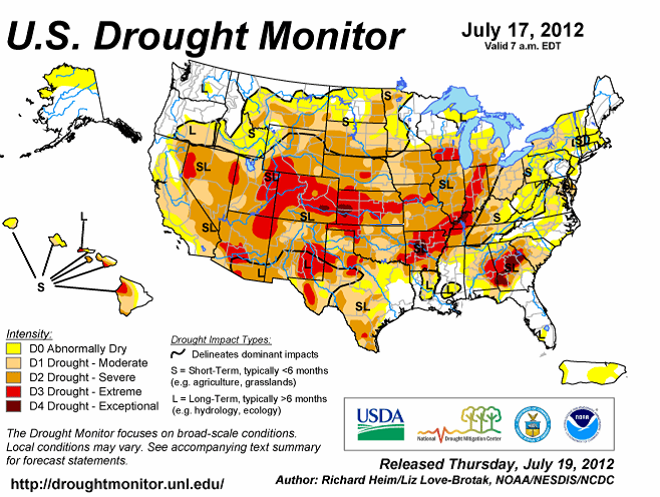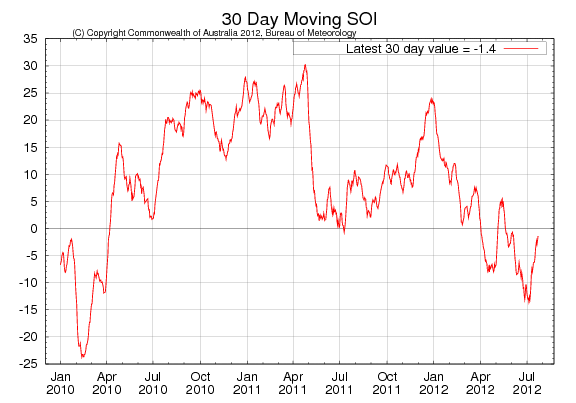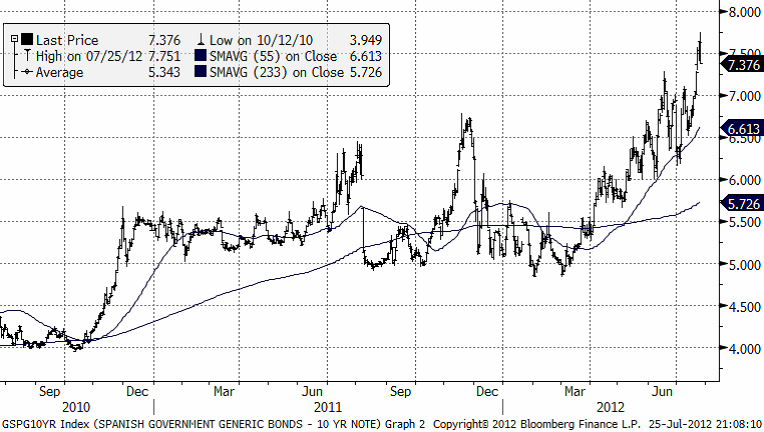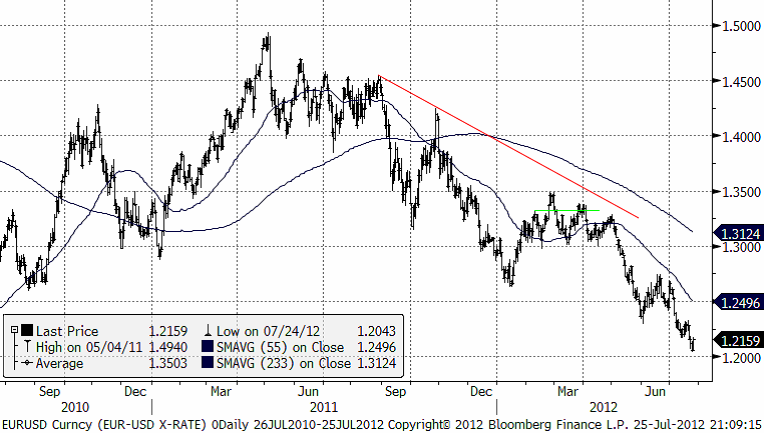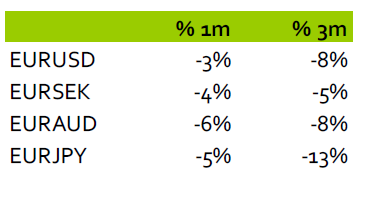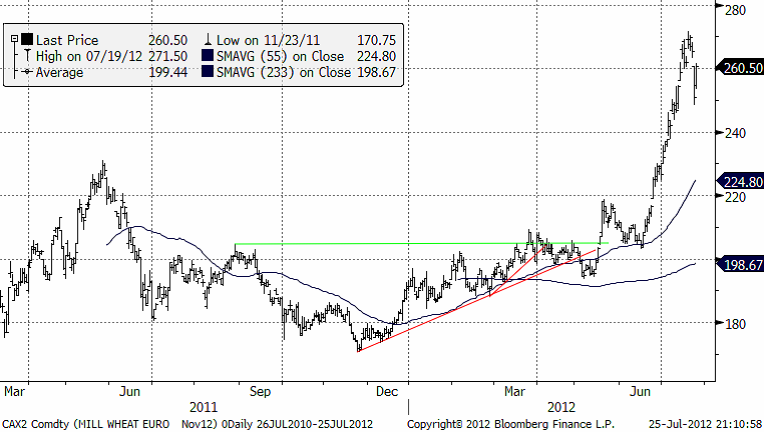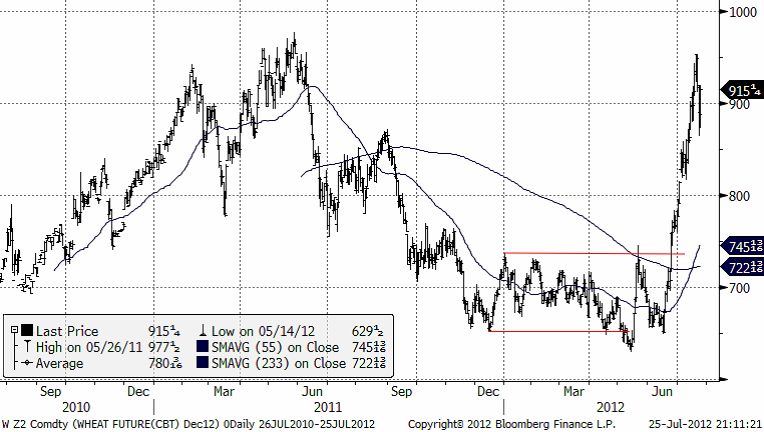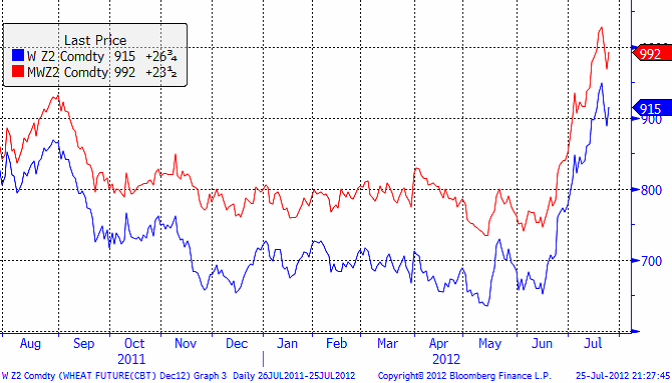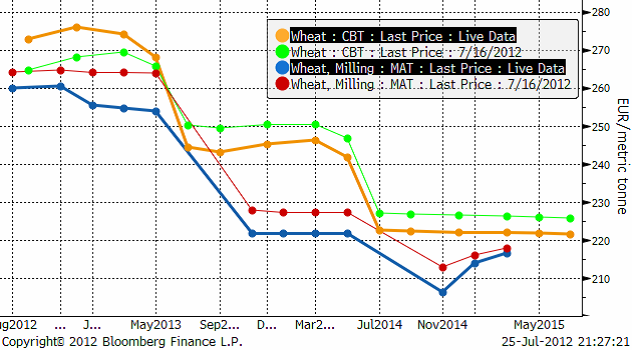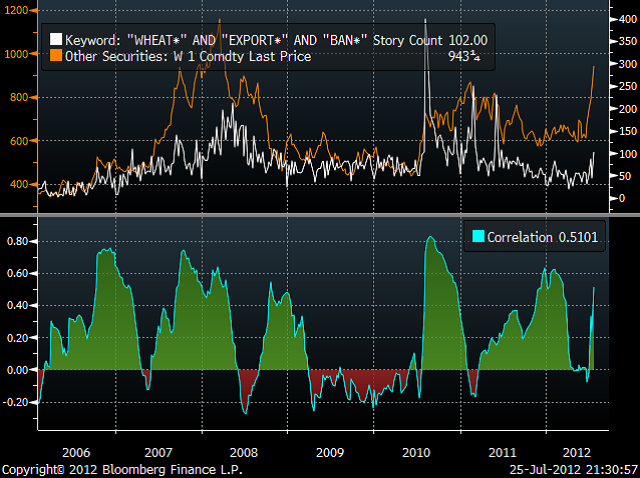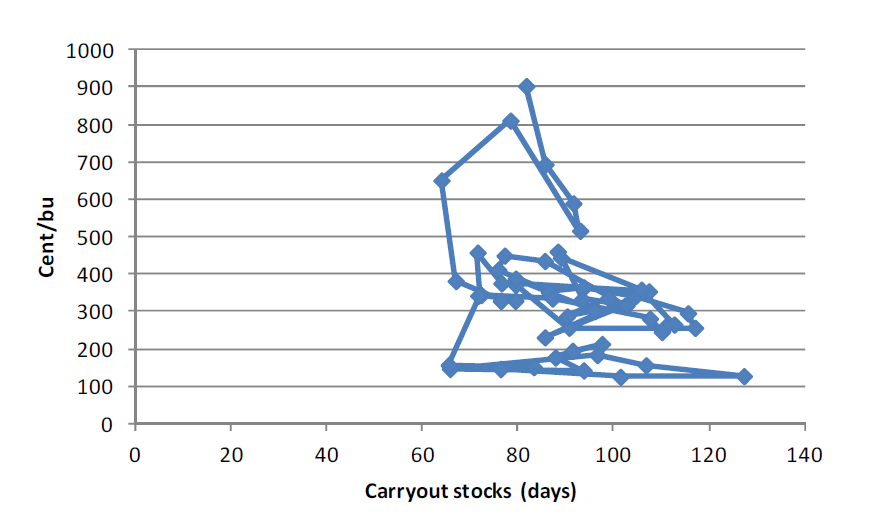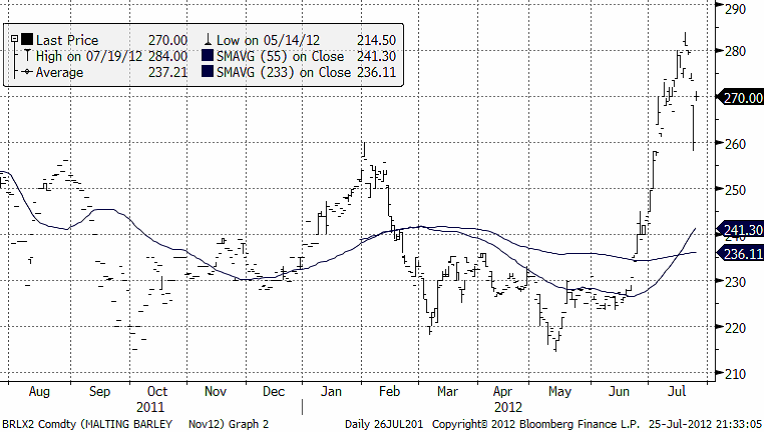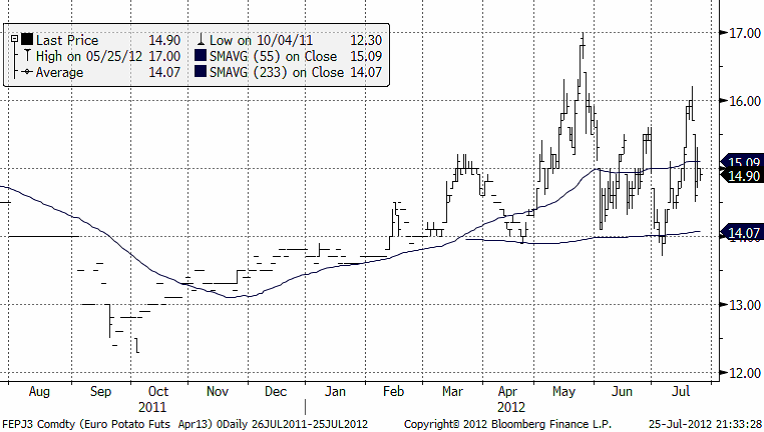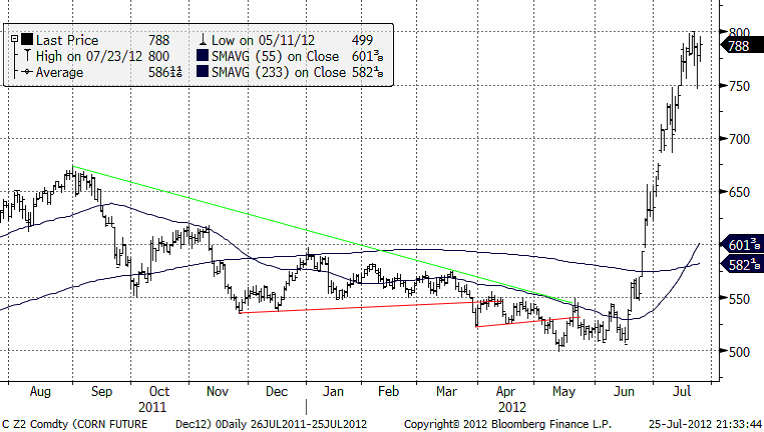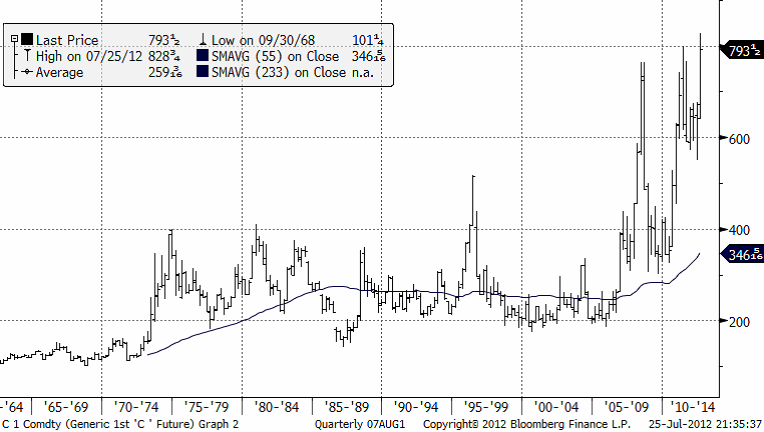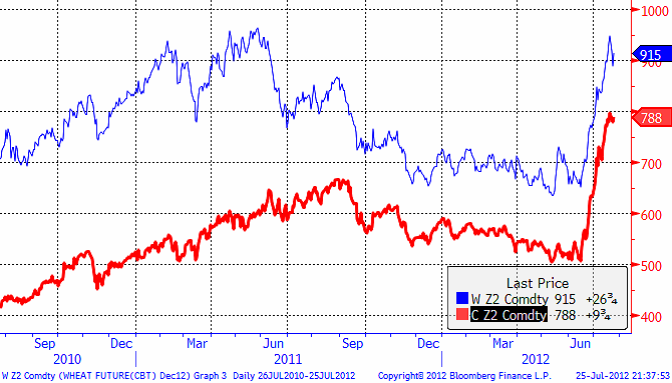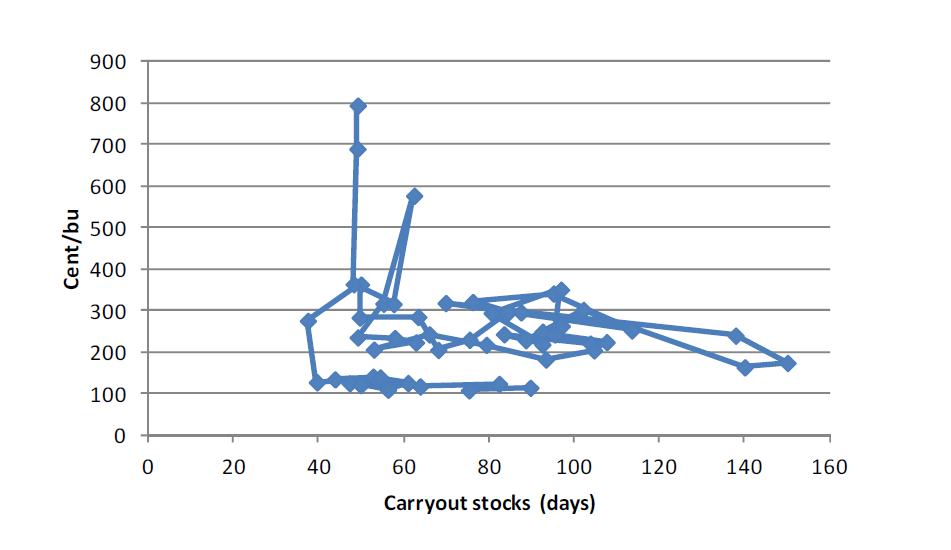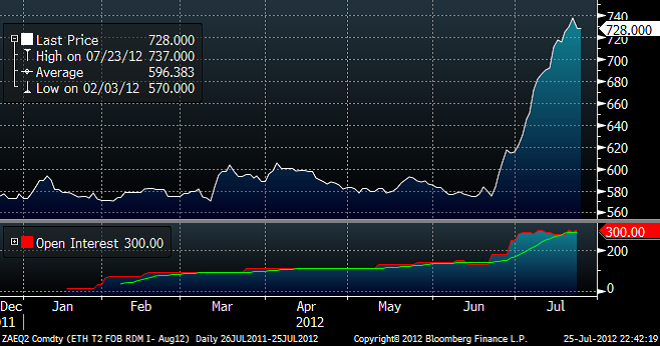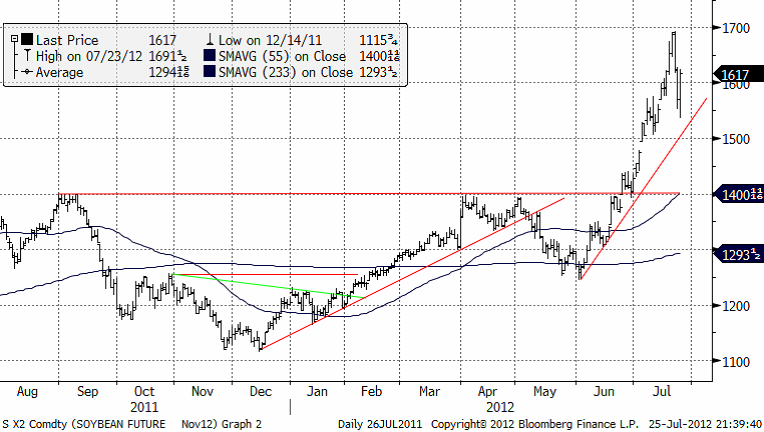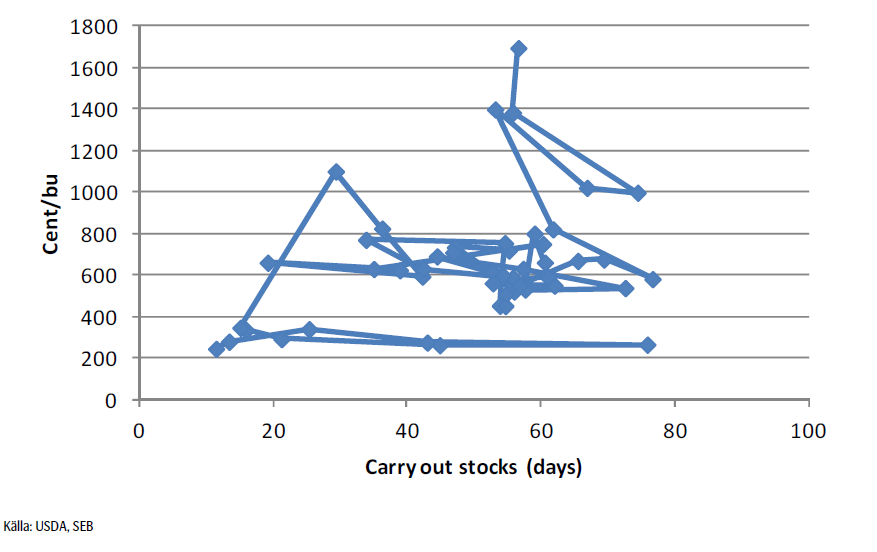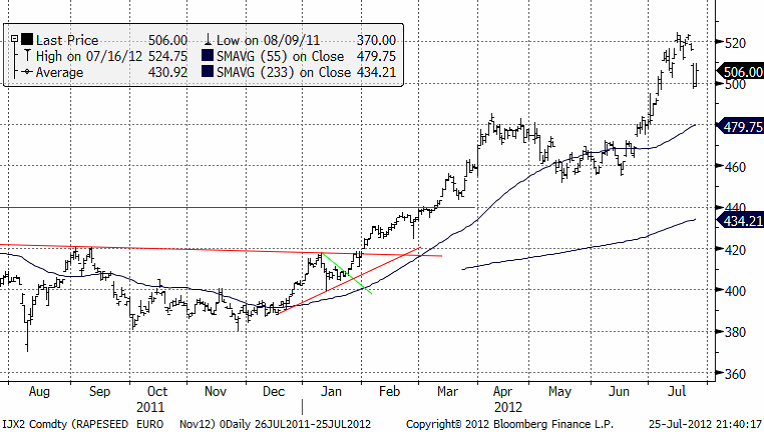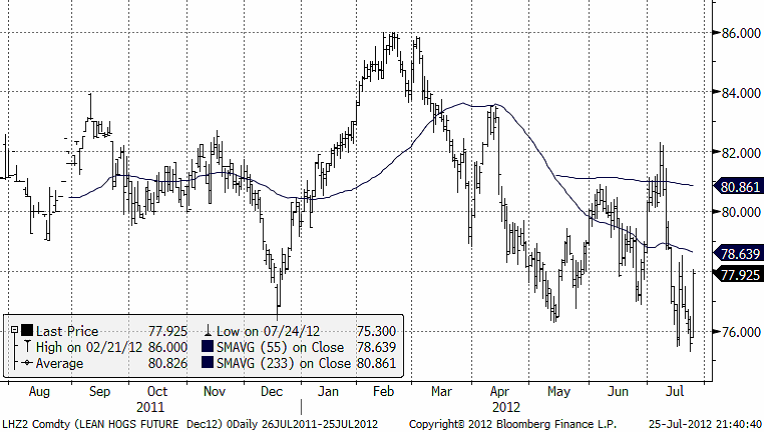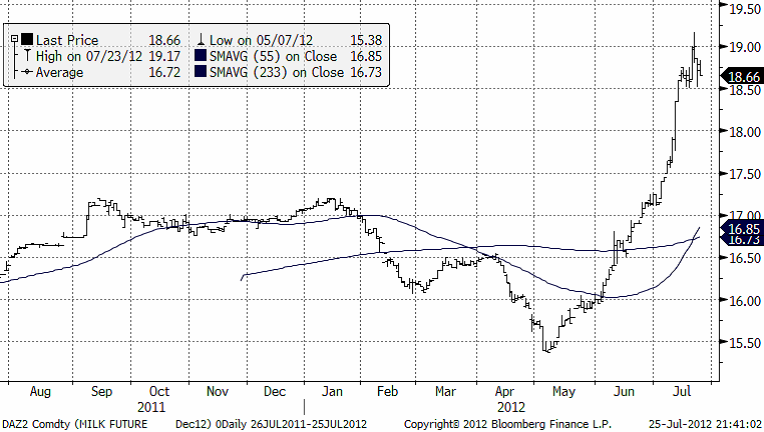Analys
SEB – Jordbruksprodukter, 26 juli 2012
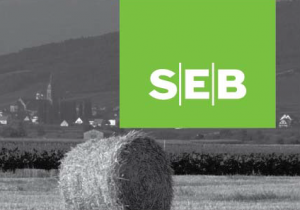 Inledning
Inledning
Det är nu en månad sedan ni fick vårt senaste veckobrev. I den ändrade vi vår marknadstro från negativ till positiv. Men prisuppgångarna på jordbruksprodukter sedan dess har varit våldsammare än vad vi hade kunnat tänka oss för en månad sedan.
Den senaste månaden har majspriset stigit med 26%. Chicagovetet har gått upp med 25% och kostar nu återigen, för alla löptider, mer än Matif:s kvarnvete. Matif-vetet har ”bara” stigit med 18%. Sojabönorna med 14%. I gårdagens Dagens Industri kunde vi läsa en chock-artikel om risken för kraftigt högre ölpriser. Det har vi svårt att förstå eftersom maltkornet på Matif den senaste månaden har stigit med 13% och det senaste året med 2%.
Vi fortsätter att ha en vy om högre priser på vete, maltkorn, majs, och sojabönor.
Odlingsväder
Det är väl knappast någon nyhet att det råder torka i USA. NOAA har klassat torkan som den värsta sedan 1954. Nedan ser vi den senaste torka-rapporten. NOAA förutspår en förlängning av torkan in i oktober, vilket kan ha en negativ inverkan på höstsådden av vete.
Southern Oscillation Index har stigit från El Niño-nivåer på mer än -8. Nu ligger indexet på -1.4. Det indikerar neutrala ENSO-förhållanden. Sådden i Argentina är i full gång och >80% är redan i marken, dock i betydligt mindre omfattning än tidigare år. Det är böndernas protest mot presidentens konfiskatoriska skatt på veteproduktionen. Både Rosario Grain Exchange och BAGE har estimerat att arealen är 22% mindre än förra året. USDA har INTE tagit hänsyn till denna minskning i sitt estimat från juli WASDE.
Eurokrisen
Samtidigt som produktionen minskar genom torka på olika håll i världen, skakar ekonomierna i eurolandet. Nedan ser vi räntenivån på obligationer utgivna av den spanska staten, med 10 års löptid. En räntenivå på över 6% har tidigare angetts som en räntenivå som gör att räntorna spränger landets budget i framtiden. Av allt att döma ser Spanien ut att vara nästa land att följa Grekland.
Under tiden, kräver stödpartierna för Tysklands förbundskansler Merkel, att Tyskland ska kräva att Grekland lämnar eurosamarbetet. Detta sker samtidigt som ratinginstitutet Moody’s tillkännagivit att de kan komma att sänka Tysklands kreditvärdighet från ”Aaa”. Tyskland har hittills gått med på att plocka upp notan för de tillgångsvärden som gått upp i rök i problemländerna i södra Europa. Eftersom Merkel och före detta franska presidenten Sarkozy valde att satsa hela Europa, istället för att låta länderna som hade problem ta itu med dem själva, har euron kommit på fall. Nedan ser vi priset på en euro i terminer av dollar. Och då ska vi betänka att USA i sig är ett imperium av skulder, det också.
Nedan ser vi eurons förändring mot fyra olika valutor, dels mot dollarn och dels mot starkare valutor.
Vete
Matifvetet med novemberleverans nådde upp till 271.50 den 19 juli, men har sedan dess rekylerat ner till 260.50 euro per ton.
Nedan ser vi Chicagovetet med leverans i december. Efter att motståndet på 740 cent bröts för en månad sedan har priset gått upp till 915 cent i skrivande stund. Det är en större uppgång än Matifvetet gjorde, i synnerhet när man beaktar att dollarn har stärkts mot euron under den här perioden.
Allt höstvete är skördat i USA nu och eventuell torka kan skada vårvetet. Man skulle därför kunna tro att vårvetet stigit mer i pris i USA, men som vi ser i nedanstående diagram är det inte fallet. Vårvete av sorten Red Spring Wheat handlas på börsen i Minneapolis. Vårvetet är naturligtvis dyrare än Chicagovetet.
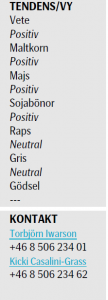 Just nu visar väderleksprognoserna att vårveteregionerna i USA kommer att ha det ganska fuktigt ända fram till efter helgen, åtminstone. Det är bra för de norra delarna av odlingsområdet, men för de södra delarna kan nederbörden vara allt för sen.
Just nu visar väderleksprognoserna att vårveteregionerna i USA kommer att ha det ganska fuktigt ända fram till efter helgen, åtminstone. Det är bra för de norra delarna av odlingsområdet, men för de södra delarna kan nederbörden vara allt för sen.
Nedan ser vi hur terminspriserna på Matif och Chicago förändrats den senaste veckan. Vi ser nu att det råder backwardation både på Matif och i Chicago. Backwardation återspeglar marknadens tro på att bristen just nu är temporär och kommer att lösas i framtiden genom mer produktion eller ransonering av konsumtionen. Den som har vete att sälja nu bör därför sälja den till marknadens höga pris nu.
Marknaden säger att spotpriset väntas att bli lägre i framtiden. Den lantbrukare som hoppas på högre (spot-) priser för att sälja till ett högre pris, gör bäst i att sälja sitt vete spot snarast och köpa terminer.
Genom att göra det får man in pengar, som ger ränta. Terminerna kostar mindre än spot. Man kan alltså sälja x antal ton dyrare än man köper dem på, på terminsmarknaden. Detta för dem som tror på högre priser, alltså.
Vi ser i terminskurvorna ovan att Chicago återigen ligger över Matif för alla löptider. Ska man prissäkra framåt i tiden ger Chicago alltså ett högre pris än Matif.
När priset är högt pga dåliga skördar finns alltid risken att politiker i olika producentländer inför exportbegränsningar, vilket förvärrar situationen på världsmarknaden. Rysslands jordbruksminister har hittills, senast förra veckan, sagt att Ryssland inte tänker införa exportbegränsningar, men med den torka som finns i fd Sovjetunionen, är det allt fler som tror att ett exportstopp kan komma. Vi kan se att ”snacket” om exportstopp på global basis ökar genom att göra en nyckelordssökning i nyhetsartiklar på nätet. Nedan ser vi ett diagram (vit kurva) för antalet artiklar per vecka som innehåller samtliga ord ”Export” och ”Ban” och ”wheat”. Den senaste veckan var det 102 sådana artiklar. I diagrammet nedan ser vi också vetepriset i Chicago (röd kurva). I den nedre delen av diagrammet ser vi korrelationen mellan prisförändringen på vete och förändringen i antalet sådana nyhetsartiklar som innehåller wheat+export+ban.
Vi ser att när det blir populärt att prata om wheat+export+ban i nyheterna, stiger vetepriset mot riktigt höga höjder. Det ser ut som om det kommer att komma exportbegränsningar. Indien har redan fryst all export av vete från landet, då man har en 23% sämre monsun (nederbörd) än vanligt. I slutet av förra veckan sade det ryska jordbruksministeriet att rysk veteskörd väntas bli 45 mt. USDA förutspådde i juli WASDE 49 mt. Privata analytiker hakade på och nämnde estimat på 41 – 42.5 mt. I Ukraina är hektarskörden ca 27% lägre än förra året. I början av månaden kom som vanligt USDA med sin WASDE-rapport. För att sätta den lagerstatistiken i perspektiv med pris och historiska relationer mellan pris och utgående lager, kan vi titta på nedanstående diagram. Varje punkt är USDA:s estimat i juli, varje år sedan 1960, jämte det pris som då rådde på CBOT för en bushel av vete. Vi ser att vi nu är i icke-kartlagt territorium. Priset förefaller vara Väldigt högt i förhållande till historiska relationer mellan pris och globala utgående lager. Dock noterar vi att i juli 2008 hade vi en relation som var i närheten av dagens nivå. Jämfört med juli 2008 är priset nu lite högre (900 cent istället för 800) och utgående lager väntas (än så länge) vara lite högre. Antagligen, kommer utgående lager att reduceras i nästa rapport, och då blir priset kanske lite lättare att acceptera, i relation till 2008. USDA har en välkänd tendens att inte släppa alla dåliga nyheter samtidigt, utan en WASDEsäsong brukar bjuda på ”mer av samma sak” i konsekutiva rapporter.
Vi minns också förstås vad som hände med vetepriset efter 2008. Ett högt pris följs av mer produktion och därmed lägre priser.
Maltkorn
Novemberkontraktet på maltkorn har följt med vete upp, men uppgången har inte varit alls lika dramatisk som för vete och majs. Tekniskt stöd finns tydligt och redan bekräftat som ett stöd på 260 euro. Så länge priset håller sig över den nivån finns inget pressande behov av att sälja terminer. Kommer det attraktiva höga priser kan det vara intressant att försöka få limiterade säljordrar fyllda.
Potatis
Potatispriset för leverans nästa år, har inte rört sig uppåt som spannmålen, utan rör sig sidledes i ett nu etablerat prisintervall mellan 14 och 16 euro per deciton. Prisintervall handlar man genom att försöka sälja i den övre delen av intervallet och försöka köpa i den nedre. Samtidigt är man vaksam på om priset rör sig utanför intervallet. Det brukar kunna vara en indikation på att priset ska röra sig ytterligare en bit åt samma håll.
Majs
Priset på decembermajs har som bekant rusat upp till 800 cent. När man pratar med folk i marknaden råder total samstämmighet att vi ännu inte sett toppnoteringen på majs. Sådan samstämmighet brukar i och för sig innebära att man faktiskt har sett toppnoteringen.
Det har kommit regn i USA nu men det rör sig nu bort och följs av torrt väder. För stora arealer kom nederbörden för sent, därför att majsplantorna helt enkelt är döda. På fredag kommer Stocks report från USDA.
De priser vi ser nu är faktiskt de högsta nivåerna på 50 år (och därmed de högsta någonsin). Nedan ser vi majspriset de senaste 50 åren, på kvartalsvis data.
Nedan ser vi priset på decemberkontrakten för vete och majs. Vi ser att majs trendmässigt har stigit mycket mer än vetepriset. Man kan tolka det som att det är majspriset som trycker vetepriset uppåt. De stora problemen finns ju i majsproduktionen i USA, inte i samma utsträckning i veteproduktionen.
Relationen mellan pris och utgående lager per juli sedan början av 60-talet ser vi nedan. Vi ser att vi aldrig har sett en så ”dyr” relation mellan majspris och utgående lager. Vi ser också att ett utgående lager på 40 dagar, där vi är nu, i princip är en bottennivå; att det är skrämmande tomt i lagren. När det är tomt i lagren kan priset på en så billig, men livsnödvändig vara som mat naturligtvis bli nästan hur hög som helst.
Det högre majspriset har dragit med sig det EU-domestika priset på etanol. Nedan ser vi priset för etanol FOB Rotterdam, inklusive importskatt, kallat ”T2”. För alla som producerar etanol med vete (i Europa) är detta goda nyheter; ”gefundenes fressen”.
Sojabönor
Efter att sojabönspriset bröt det tekniskt starka motståndet på 14 dollar, gick priset raskt upp till 17 dollar. Som vi ser av stödlinjen inritad precis under prisuppgången, är uppåttrenden ännu inte bruten, trots den kraftiga rekylen för två dagar sedan. Ett nytt test av 17 dollar är troligt.
USA hade förra veckan exporterat 1400 mbu. USDA hade förutspått 1340 mbu för hela marknadsföringsåret. Det återstår 7 veckor på exportsäsongen och det blir naturligtvis en ännu högre slutsiffra än vad USDA hade förväntat sig. Enligt analytikern Noel Fryer har USDA överskattat carry-instocks.
Vädret har inte gynnat avkastningen i USA. Det är ca 7 månader kvar innan Sydamerikas skörd kommer. Det finns tecken på att t ex kycklingproduktionen i USA minskar något och att det sker ransonering bland konsumenter, men den är än så länge väldigt liten om man sätter den i perspektiv med produktionsbortfallen. Det finns alltså fundamental anledning till att priset skulle kunna gå högre.
Nedan ser vi relationen mellan pris och utgående lager, enligt USDA. USDA får med all sannolikhet sänka sitt estimat av utgående lager, så vi får tänka oss att juli-2012-punkten (den högsta i diagrammet) kommer att flyttas till vänster i diagrammet. Priset är högt, men det är inte orimligt att tänka sig att relationen kan stämma överens med de senaste årens relation mellan lager och pris.
Raps
Priset på novemberterminen befinner sig alltjämt i en obruten uppåtgående trend.
Med tanke på att rapsen noteras i euro, som är svag, kan man tänka sig högre priser framöver.
Gris
Decemberkontraktet har etablerat ett bekräftat stödområde på 76 – 77 cent. Med högre foderkostnader och den minskande lönsamheten för grisproducenterna bör det finnas utsikter för ett högre pris på lean hogs.
Mjölk
Mjölkpriset har stigit rejält. Först vid 19 cent per pund kom det in säljare. Nu står priset och väger och det återstår att se om 19 cent var toppnoteringen eller om det blir ett ytterligare test av 19.50 och om priset ska nå 20 cent.
Socker
Vi brukar inte skriva om socker, men det är en intressant råvara för många bönder. Marknaden är också intressant för att den är ett sådant misslyckande för EU. EU har ett system med produktionskvoter för att hålla nere produktionen. Det innebär att EU inte är självförsörjande på socker. Istället har man ett system där företag i EU kan importera socker utan tull från U-länder som ett slags bistånd till dessa länder.
Problemet är att dessa länder inte förmår producera tillräckligt. Då tvingas importörerna köpa från producentländer där EU:s mycket högra importskatt tillämpas. Det gäller t ex import av socker från Brasilien. Eftersom detta pris då är det som mättar sockersuget i EU, är det det som blir marknadspriset.
Som vi ser nedan är priset på socker inom EU, såsom handlat på Euronext i London, betydligt högre än världsmarknadspriset på socker, såsom handlat på ICE i New York.
Den stora förloraren är Europeiska konsumenter, t ex europeiska biodlare, om vi nu ska nämna någon kategori inom de gröna näringarna. De stora vinnarna är sockerbolagen, t ex Nord- och Zudzucker, som alltså kan boka hela prisskillnaden som ren vinst.
I diagrammet nedan ser vi i den nedre delen av diagrammet att relationen mellan priset inom EU och världsmarknadspriset har vidgats. Priset inom EU ligger just nu 23% högre än på världsmarknaden.
Nedan ser vi terminspriserna och förändringarna den senaste veckan. De övre två kurvorna är EUdomestika terminsmarknaden. De lägre är de internationella priserna.
[box]SEB Veckobrev Jordbruksprodukter är producerat av SEB Merchant Banking och publiceras i samarbete och med tillstånd på Råvarumarknaden.se[/box]
Disclaimer
The information in this document has been compiled by SEB Merchant Banking, a division within Skandinaviska Enskilda Banken AB (publ) (“SEB”).
Opinions contained in this report represent the bank’s present opinion only and are subject to change without notice. All information contained in this report has been compiled in good faith from sources believed to be reliable. However, no representation or warranty, expressed or implied, is made with respect to the completeness or accuracy of its contents and the information is not to be relied upon as authoritative. Anyone considering taking actions based upon the content of this document is urged to base his or her investment decisions upon such investigations as he or she deems necessary. This document is being provided as information only, and no specific actions are being solicited as a result of it; to the extent permitted by law, no liability whatsoever is accepted for any direct or consequential loss arising from use of this document or its contents.
About SEB
SEB is a public company incorporated in Stockholm, Sweden, with limited liability. It is a participant at major Nordic and other European Regulated Markets and Multilateral Trading Facilities (as well as some non-European equivalent markets) for trading in financial instruments, such as markets operated by NASDAQ OMX, NYSE Euronext, London Stock Exchange, Deutsche Börse, Swiss Exchanges, Turquoise and Chi-X. SEB is authorized and regulated by Finansinspektionen in Sweden; it is authorized and subject to limited regulation by the Financial Services Authority for the conduct of designated investment business in the UK, and is subject to the provisions of relevant regulators in all other jurisdictions where SEB conducts operations. SEB Merchant Banking. All rights reserved.
Analys
Tightening fundamentals – bullish inventories from DOE

The latest weekly report from the US DOE showed a substantial drawdown across key petroleum categories, adding more upside potential to the fundamental picture.

Commercial crude inventories (excl. SPR) fell by 5.8 million barrels, bringing total inventories down to 415.1 million barrels. Now sitting 11% below the five-year seasonal norm and placed in the lowest 2015-2022 range (see picture below).
Product inventories also tightened further last week. Gasoline inventories declined by 2.1 million barrels, with reductions seen in both finished gasoline and blending components. Current gasoline levels are about 3% below the five-year average for this time of year.
Among products, the most notable move came in diesel, where inventories dropped by almost 4.1 million barrels, deepening the deficit to around 20% below seasonal norms – continuing to underscore the persistent supply tightness in diesel markets.
The only area of inventory growth was in propane/propylene, which posted a significant 5.1-million-barrel build and now stands 9% above the five-year average.
Total commercial petroleum inventories (crude plus refined products) declined by 4.2 million barrels on the week, reinforcing the overall tightening of US crude and products.


Analys
Bombs to ”ceasefire” in hours – Brent below $70

A classic case of “buy the rumor, sell the news” played out in oil markets, as Brent crude has dropped sharply – down nearly USD 10 per barrel since yesterday evening – following Iran’s retaliatory strike on a U.S. air base in Qatar. The immediate reaction was: “That was it?” The strike followed a carefully calibrated, non-escalatory playbook, avoiding direct threats to energy infrastructure or disruption of shipping through the Strait of Hormuz – thus calming worst-case fears.

After Monday morning’s sharp spike to USD 81.4 per barrel, triggered by the U.S. bombing of Iranian nuclear facilities, oil prices drifted sideways in anticipation of a potential Iranian response. That response came with advance warning and caused limited physical damage. Early this morning, both the U.S. President and Iranian state media announced a ceasefire, effectively placing a lid on the immediate conflict risk – at least for now.
As a result, Brent crude has now fallen by a total of USD 12 from Monday’s peak, currently trading around USD 69 per barrel.
Looking beyond geopolitics, the market will now shift its focus to the upcoming OPEC+ meeting in early July. Saudi Arabia’s decision to increase output earlier this year – despite falling prices – has drawn renewed attention considering recent developments. Some suggest this was a response to U.S. pressure to offset potential Iranian supply losses.
However, consensus is that the move was driven more by internal OPEC+ dynamics. After years of curbing production to support prices, Riyadh had grown frustrated with quota-busting by several members (notably Kazakhstan). With Saudi Arabia cutting up to 2 million barrels per day – roughly 2% of global supply – returns were diminishing, and the risk of losing market share was rising. The production increase is widely seen as an effort to reassert leadership and restore discipline within the group.
That said, the FT recently stated that, the Saudis remain wary of past missteps. In 2018, Riyadh ramped up output at Trump’s request ahead of Iran sanctions, only to see prices collapse when the U.S. granted broad waivers – triggering oversupply. Officials have reportedly made it clear they don’t intend to repeat that mistake.
The recent visit by President Trump to Saudi Arabia, which included agreements on AI, defense, and nuclear cooperation, suggests a broader strategic alignment. This has fueled speculation about a quiet “pump-for-politics” deal behind recent production moves.
Looking ahead, oil prices have now retraced the entire rally sparked by the June 13 Israel–Iran escalation. This retreat provides more political and policy space for both the U.S. and Saudi Arabia. Specifically, it makes it easier for Riyadh to scale back its three recent production hikes of 411,000 barrels each, potentially returning to more moderate increases of 137,000 barrels for August and September.
In short: with no major loss of Iranian supply to the market, OPEC+ – led by Saudi Arabia – no longer needs to compensate for a disruption that hasn’t materialized, especially not to please the U.S. at the cost of its own market strategy. As the Saudis themselves have signaled, they are unlikely to repeat previous mistakes.
Conclusion: With Brent now in the high USD 60s, buying oil looks fundamentally justified. The geopolitical premium has deflated, but tensions between Israel and Iran remain unresolved – and the risk of missteps and renewed escalation still lingers. In fact, even this morning, reports have emerged of renewed missile fire despite the declared “truce.” The path forward may be calmer – but it is far from stable.
Analys
A muted price reaction. Market looks relaxed, but it is still on edge waiting for what Iran will do

Brent crossed the 80-line this morning but quickly fell back assigning limited probability for Iran choosing to close the Strait of Hormuz. Brent traded in a range of USD 70.56 – 79.04/b last week as the market fluctuated between ”Iran wants a deal” and ”US is about to attack Iran”. At the end of the week though, Donald Trump managed to convince markets (and probably also Iran) that he would make a decision within two weeks. I.e. no imminent attack. Previously when when he has talked about ”making a decision within two weeks” he has often ended up doing nothing in the end. The oil market relaxed as a result and the week ended at USD 77.01/b which is just USD 6/b above the year to date average of USD 71/b.

Brent jumped to USD 81.4/b this morning, the highest since mid-January, but then quickly fell back to a current price of USD 78.2/b which is only up 1.5% versus the close on Friday. As such the market is pricing a fairly low probability that Iran will actually close the Strait of Hormuz. Probably because it will hurt Iranian oil exports as well as the global oil market.
It was however all smoke and mirrors. Deception. The US attacked Iran on Saturday. The attack involved 125 warplanes, submarines and surface warships and 14 bunker buster bombs were dropped on Iranian nuclear sites including Fordow, Natanz and Isfahan. In response the Iranian Parliament voted in support of closing the Strait of Hormuz where some 17 mb of crude and products is transported to the global market every day plus significant volumes of LNG. This is however merely an advise to the Supreme leader Ayatollah Ali Khamenei and the Supreme National Security Council which sits with the final and actual decision.
No supply of oil is lost yet. It is about the risk of Iran closing the Strait of Hormuz or not. So far not a single drop of oil supply has been lost to the global market. The price at the moment is all about the assessed risk of loss of supply. Will Iran choose to choke of the Strait of Hormuz or not? That is the big question. It would be painful for US consumers, for Donald Trump’s voter base, for the global economy but also for Iran and its population which relies on oil exports and income from selling oil out of that Strait as well. As such it is not a no-brainer choice for Iran to close the Strait for oil exports. And looking at the il price this morning it is clear that the oil market doesn’t assign a very high probability of it happening. It is however probably well within the capability of Iran to close the Strait off with rockets, mines, air-drones and possibly sea-drones. Just look at how Ukraine has been able to control and damage the Russian Black Sea fleet.
What to do about the highly enriched uranium which has gone missing? While the US and Israel can celebrate their destruction of Iranian nuclear facilities they are also scratching their heads over what to do with the lost Iranian nuclear material. Iran had 408 kg of highly enriched uranium (IAEA). Almost weapons grade. Enough for some 10 nuclear warheads. It seems to have been transported out of Fordow before the attack this weekend.
The market is still on edge. USD 80-something/b seems sensible while we wait. The oil market reaction to this weekend’s events is very muted so far. The market is still on edge awaiting what Iran will do. Because Iran will do something. But what and when? An oil price of 80-something seems like a sensible level until something do happen.
-

 Nyheter4 veckor sedan
Nyheter4 veckor sedanUppgången i oljepriset planade ut under helgen
-

 Nyheter3 veckor sedan
Nyheter3 veckor sedanMahvie Minerals växlar spår – satsar fullt ut på guld
-

 Nyheter4 veckor sedan
Nyheter4 veckor sedanLåga elpriser i sommar – men mellersta Sverige får en ökning
-

 Nyheter2 veckor sedan
Nyheter2 veckor sedanOljan, guldet och marknadens oroande tystnad
-

 Nyheter2 veckor sedan
Nyheter2 veckor sedanJonas Lindvall är tillbaka med ett nytt oljebolag, Perthro, som ska börsnoteras
-

 Analys4 veckor sedan
Analys4 veckor sedanVery relaxed at USD 75/b. Risk barometer will likely fluctuate to higher levels with Brent into the 80ies or higher coming 2-3 weeks
-

 Analys3 veckor sedan
Analys3 veckor sedanA muted price reaction. Market looks relaxed, but it is still on edge waiting for what Iran will do
-

 Nyheter2 veckor sedan
Nyheter2 veckor sedanDomstolen ger klartecken till Lappland Guldprospektering


